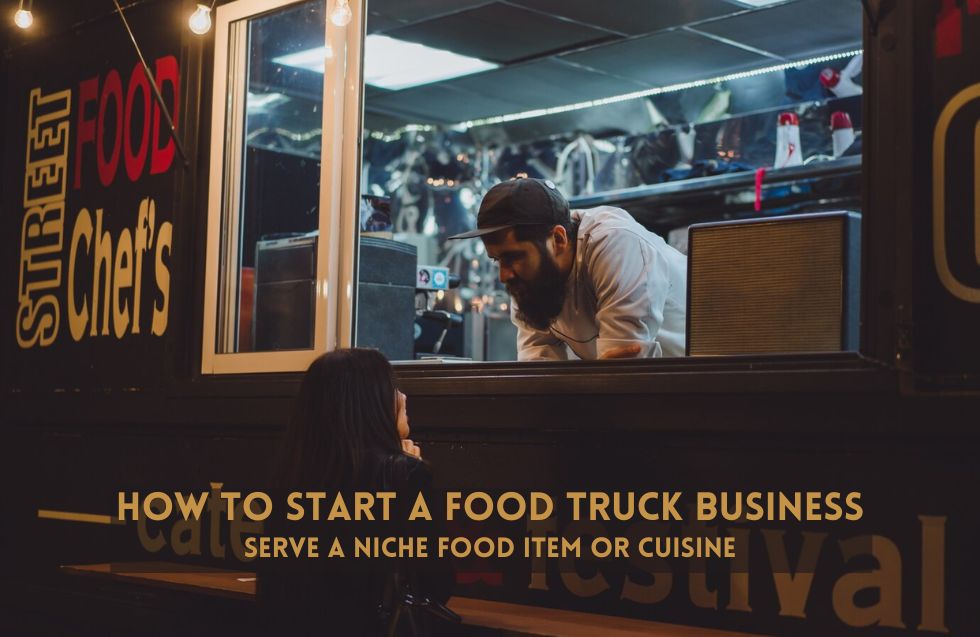Starting a food truck business is an exciting opportunity to bring your culinary dreams to life while meeting the demand for innovative and mobile dining experiences. To stand out in the competitive food truck market, focusing on a niche food item or cuisine can be your recipe for success. Here’s a comprehensive guide on how to start a food truck business centered around a unique food concept.
Step 1: Define Your Niche
Your niche sets the tone for your entire business. This could be inspired by your personal culinary passions, regional favorites, or emerging food trends.
- Why it matters: A unique niche helps you stand out in the competitive food truck market and creates a strong identity for your brand.
- How to choose: Look at your community’s dining scene. Are there unmet needs? For example, if your city lacks vegan comfort food, that could be your winning niche.
- Test your concept: Host pop-ups or participate in local food events to gauge interest in your niche cuisine.
The foundation of your food truck business begins with identifying a niche that reflects your passion and appeals to your target audience. A niche food item or cuisine can be:
- Cultural cuisine: Authentic street tacos, Korean BBQ, or Mediterranean mezze.
- Dietary preferences: Vegan desserts, gluten-free baked goods, or keto-friendly meals.
- Unique combinations: Sushi burritos, waffle sandwiches, or Nitrogen ice cream.
- Local flavors: A twist on your city’s iconic dishes, like lobster rolls in Maine or beignets in New Orleans.
Example: A truck specializing in “Jamaican Jerk Tacos” combines a popular dish with a unique cultural twist, drawing attention and sparking curiosity.
Tip: Research food trends and identify gaps in the local food scene to find a concept that resonates.
Step 2: Develop Your Business Plan
Every successful venture begins with a solid plan. Include these critical elements:
- Concept and Menu: Clearly define your offerings. Keep the menu concise (3–5 main items) to maintain quality and ease of preparation.
- Target Market: Determine who your customers are. Are they office workers needing a quick lunch, or foodies seeking exotic flavors?
- Budget: Account for startup costs like the truck, kitchen equipment, marketing, permits, and initial inventory. Estimate ongoing costs such as fuel, food supplies, and staff wages.
- Marketing Strategy: Plan for promotions, social media engagement, and collaborations to build your brand.
Pro Tip: Consider writing a mission statement that highlights your passion and the unique value your food truck brings to the community.
Step 3: Understand Licensing and Regulations
Food trucks must comply with local laws to operate legally.
- Licenses and Permits: Common requirements include a business license, food handler’s permit, and vehicle permits.
- Health and Safety: Pass health inspections and maintain cleanliness standards.
- Zoning Rules: Learn where you can and can’t park your truck, including restrictions near schools or residential areas.
Operating a food truck requires adhering to local regulations. Secure the following:
- Food truck permits and licenses
- Health and safety certifications
- Parking permits
- Insurance for liability and vehicle coverage
How to prepare: Visit your city’s business bureau or consult with a legal professional to ensure you meet all requirements.
Step 4: Invest in the Right Equipment
Your truck is your kitchen on wheels. Equip it with essentials tailored to your niche cuisine:
- Essential tools: Depending on your menu, you might need grills, fryers or specialty equipment for your unique menu items, refrigeration units for perishable ingredients, prep counters, and sinks.
- Cost considerations: A new truck can cost $75,000–$150,000, while a used one might cost less but require renovations.
- Technology: Equip your truck with a POS system to process payments efficiently, including cashless options like credit cards or mobile payments.
Pro Tip: Opt for energy-efficient appliances to lower operating costs and make your truck eco-friendlier.
Step 5: Create a Memorable Brand
Branding is your opportunity to make a lasting impression.
- Truck Design: Use vibrant colors, striking graphics, and a clear logo to attract attention.
- Brand Voice: Craft a unique voice for your business—whether it’s fun and playful or sophisticated and gourmet.
- Storytelling: Share your inspiration for the truck and your love for the cuisine to create a personal connection with customers.
Consider:
- Logo and Truck Design: Eye-catching visuals that showcase your concept.
- Catchy Name: Something memorable and relevant to your cuisine.
- Consistent Messaging: Reflect your niche in marketing and customer interaction.
Example: A sushi burrito truck might have a name like “Roll & Go,” with a design featuring colorful fish and bamboo accents.
Step 6: Perfect Your Menu and Process
Focus on a concise menu with 3–5 items to streamline operations and ensure quality. Simplify your menu to focus on quality and speed.
- Consistency: Every dish should taste the same regardless of when or where it’s ordered. Test recipes to perfection and train your staff to maintain consistency.
- Ingredient Sourcing: Use high-quality, fresh ingredients that align with your niche.
- Efficient Workflow: Organize your kitchen to minimize preparation time and maximize productivity.
Pro Tip: Regularly rotate seasonal specials to keep your menu exciting and customers coming back.
Step 7: Build Buzz Before Launch
Start promoting your food truck before you hit the streets:
- Social Media Teasers: Share behind-the-scenes looks, menu sneak peeks, and launch dates. Share updates on Instagram, TikTok, or Facebook with hashtags like #FoodTruckLife or #TacoTuesday.
- Collaborate Locally: Partner with local breweries, farmers’ markets, or events to introduce your brand. Also partner with local businesses or sponsor community events to introduce your brand.
- Grand Opening Event: Host a launch day with special deals or free samples to attract customers.
Step 8: Choose Strategic Locations
The right location can make or break your food truck. Rotate between high-traffic areas such as:
- Office complexes during lunch hours.
- Parks and recreation centers on weekends.
- Festivals, fairs, and community events.
Your success largely depends on where you park your truck.
- High-Traffic Areas: Office districts, universities, or parks are prime spots.
- Event Participation: Festivals and fairs can introduce your truck to large audiences.
- Rotating Schedule: Keep customers engaged by changing locations and sharing your route on social media.
Pro Tip: Use location-tracking apps like Google Maps or proprietary food truck apps to help customers find you easily.
Use apps or GPS tracking on social media to inform customers of your daily locations.
Step 9: Leverage Technology and Marketing
Maximize your reach and customer experience:
- Food Delivery Apps: Partner with platforms like Uber Eats or DoorDash.
- Customer Feedback: Use surveys or social media polls to refine your menu. Encourage happy customers to leave positive reviews online to build credibility.
- Loyalty Programs: Offer discounts or freebies for repeat customers.
- Engage Regularly: Post updates, photos, and promotions to keep followers interested and informed.
Example: Post a daily Instagram story with your location, menu highlights, and any special deals for the day.
Step 10: Scale and Adapt
Once your food truck gains traction, explore growth opportunities:
- Fleet Expansion: Launch additional trucks with the same or new menus in different locations.
- Catering Services: Offer your cuisine for private parties, weddings, or corporate events.
- Brick-and-Mortar Expansion: Transition into a physical restaurant based on demand(ie. Transition into a restaurant or café to complement your food truck).
Starting a food truck business focused on a niche food item or cuisine requires creativity, dedication, and strategic planning. By tapping into a unique culinary concept and delivering exceptional food and service, you can carve out a loyal customer base and turn your food truck into a thriving enterprise.
Are you ready to hit the road and bring your niche cuisine to life? Let us know your concept and launch plans in the comments!












